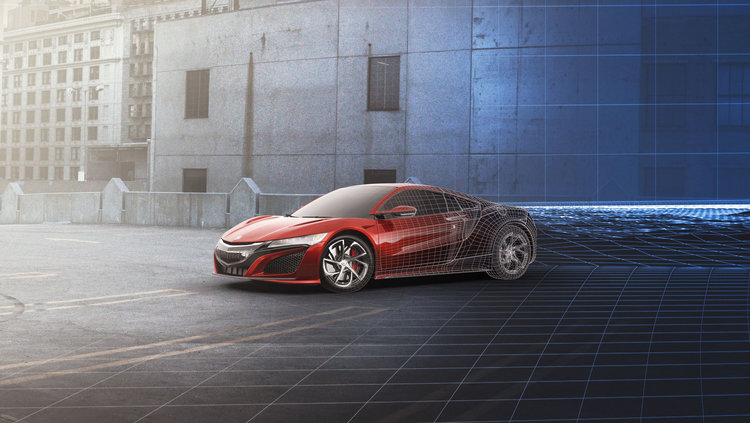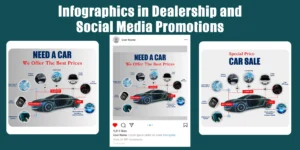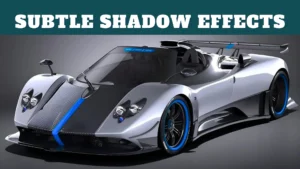Did you know that automotive advertising photography plays a crucial role in enticing consumers to buy cars? With the right imagery, car manufacturers can create an emotional connection with potential buyers, showcasing the sleek design, performance, and lifestyle associated with their vehicles.
A well-crafted photograph can make a car look irresistible, sparking the desire to get behind the wheel and experience the thrill of the open road.
Automotive advertising photography has evolved over the years to meet the changing demands of the industry. Initially, it focused on capturing the beauty and features of the car itself.
However, in recent times, it has progressed to showcase the car in real-life situations, emphasizing experiences and emotions. With advancements in technology, photographers can now capture dynamic shots of cars in motion, highlighting their performance capabilities.
This approach not only appeals to car enthusiasts but also taps into the aspirational desires of consumers, offering them a glimpse of the lifestyle a particular car can provide.
The power of automotive advertising photography lies in its ability to communicate the essence and allure of a vehicle, ultimately driving sales and influencing consumer behavior.

Table of Contents
ToggleAutomotive Advertising Photography: Driving Success through Visuals
Welcome to the exciting world of automotive advertising photography, where creativity and precision come together to capture the essence of sleek vehicles and convey their unique selling points.
In this article, we will delve into the intricacies of automotives advertising photography, exploring the techniques, challenges, and benefits of this specialized genre.
Whether you are an aspiring photographer or a marketing professional looking to enhance your brand’s visual presence, this comprehensive guide will equip you with the knowledge to drive success through captivating automotive images.
The Power of Visual Storytelling
Automotive advertising photography goes beyond mere product documentation; it is an art form that aims to evoke emotion, ignite desire, and communicate a brand’s identity. One of the key elements that sets automotive photography apart is its ability to tell a compelling visual story.
Each photograph should convey a narrative, capturing the attention of potential buyers and immersing them in an aspirational lifestyle. From the gleaming metallic curves to the dynamic motion blur, every detail is carefully orchestrated to paint a captivating picture that entices viewers to explore the brand further.
Successful automotives advertising photography relies on creating a connection between the viewer and the vehicle. It transports the audience into a world where they can imagine themselves behind the wheel, experiencing the thrill of the open road.
By incorporating stunning landscapes, urban backdrops, or carefully curated environments that complement the car’s design, photographers can enhance the storytelling aspect and create a sense of atmosphere. This visual narrative not only highlights the features of the automobile but also communicates the lifestyle, values, and aspirations associated with the brand.
The Art of Technical Precision
Beyond the creative aspect, automotive advertising photography demands a high level of technical precision to capture the vehicle’s true essence. Achieving the perfect shot requires a comprehensive understanding of lighting, angles, composition, and post-processing techniques.
Lighting plays a crucial role in bringing out the contours, lines, and textures of the car, whether it’s through natural light or expertly placed artificial lighting setups. A skilled automotive photographer knows how to manipulate light to emphasize the vehicle’s best features and create a striking visual impact.
Angles and composition are also key considerations in automotive advertising photography. The photographer must find the optimal viewpoint that enhances the car’s design and evokes the desired emotions in the viewer.
The careful selection of angles can emphasize the vehicle’s lines, evoke a sense of speed and power, or invite the viewer to explore different features. Additionally, the composition should be meticulously crafted to guide the viewer’s eye and create a sense of balance and harmony within the frame.
Post-processing, although often a debated topic in photography, plays a vital role in automotive advertising photography. Editing techniques are used to fine-tune the image, enhance colors and contrast, remove distractions, and create a polished and cohesive look.
Care must be taken to strike a balance between enhancing the photograph while maintaining the integrity of the vehicle’s appearance. The goal is to capture the attention of potential buyers without misrepresenting the product.
The Challenges of Automotive Advertising Photography
While automotives advertising photography offers opportunities for creativity and visual storytelling, it also presents unique challenges that photographers must overcome. One of the primary challenges is the logistical aspect of capturing vehicles in different locations and settings.
Unlike studio photography where the photographer has full control over the environment, automotive photographers often have to work on location, dealing with factors such as weather, lighting conditions, and unexpected obstacles.
Furthermore, working with vehicles requires careful attention to detail. Reflective surfaces such as car body panels, windows, and chrome accents can present challenges in capturing clean and distortion-free reflections.
The photographer needs to position themselves and their equipment thoughtfully to minimize unwanted reflections and achieve a clear view of the vehicle.
Another challenge arises when working with high-performance automobiles, where speed is a key selling point. Capturing the sense of speed and motion while maintaining clarity and sharpness can be a technical feat.
Photographers must experiment with different techniques such as panning, long-exposure shots, and composite images to achieve the desired effect without compromising the quality of the image.
Collaboration and Effective Communication
Collaboration plays an integral role in automotives advertising photography. The photographer must work closely with the creative team, including art directors, stylists, and marketing professionals, to bring the brand’s vision to life.
Effective communication is essential to ensure that everyone is aligned on the message, aesthetic, and desired outcome of the photographs. This collaboration allows for the creation of cohesive campaigns that speak to the target audience and strengthen the brand’s identity.
Additionally, photographers often collaborate with retouchers and post-production specialists to fine-tune the images. These professionals leverage advanced editing techniques to enhance the photographs and create a consistent visual language across advertising materials.
The seamless integration of the various components, from the initial photoshoot to the final post-processing, is crucial in producing exceptional automotive advertising imagery.
The Benefits of Automotive Advertising Photography
Investing in high-quality automotive advertising photography offers numerous benefits for automotive brands. Let’s explore some of the advantages that come with captivating visuals:
Elevating Brand Perception
Creating visually stunning automotive advertisements elevates the brand’s perception in the eyes of consumers. When people see beautifully crafted images that capture the essence of the vehicle, they develop a positive association and regard the brand as more prestigious and desirable.
Strong visuals can evoke a sense of luxury, sophistication, and exclusivity, attracting potential buyers and enhancing the brand’s reputation.
Increasing Engagement and Conversion
A well-executed automotive advertising photography campaign has the power to captivate potential buyers and drive them towards conversion. Striking visuals grab attention and encourage viewers to delve deeper into the brand’s offerings, exploring features, specifications, and pricing.
When consumers are emotionally connected to a vehicle through powerful imagery, they are more inclined to take action, whether it’s booking a test drive, visiting a dealership, or making a purchase.
Setting the Brand Apart from Competitors
In a saturated market, automotive brands must find ways to differentiate themselves from competitors. Outstanding photography that showcases the brand’s unique design elements, technology, and performance can give it an edge in the industry.
By portraying the car in the most appealing light, brands can carve out a distinct identity and establish themselves as leaders in innovation, style, or other key differentiators.
Creating Emotional Connections
Automotive advertising photography has the power to evoke emotions and create meaningful connections with consumers. When viewers see themselves reflected in the imagery, envisioning the lifestyle and experiences associated with the brand, an emotional connection is established.
This emotional resonance can result in long-term loyalty and advocacy, as customers become brand ambassadors and share their positive experiences.
Driving Online and Offline Visibility
In a digital era, captivating automotive visuals are essential for online marketing efforts. Eye-catching images attract clicks, shares, and engagement on social media platforms, boosting brand visibility and driving traffic to websites or online listings.
Moreover, offline marketing materials such as billboards, brochures, and print advertisements rely on powerful imagery to attract attention and leave a lasting impression on potential buyers.
Celebrating Automotive Design
Automotive advertising photography offers a platform to celebrate the artistry and craftsmanship that goes into designing and manufacturing vehicles. By capturing every curve, detail, and feature, photographers shed light on the intricate work behind these mechanical marvels.
This celebration of automotive design not only serves as a marketing tool but also as a tribute to the passion and dedication of the engineers and designers who bring these vehicles to life.
The Future of Automotive Advertising Photography: Innovations and Trends
As technology advances and consumer preferences evolve, automotive advertising photography continues to evolve with new innovations and trends. Here are three key developments shaping the future of this dynamic field:
Immersive Experiences through Virtual Reality
Virtual reality (VR) is revolutionizing the way consumers interact with automotive brands. By utilizing VR technology, automotive advertising can offer immersive experiences that allow potential buyers to explore vehicles from the comfort of their own homes.
With virtual showrooms, interactive test drives, and customizable options, VR presents endless opportunities for brands to engage with their target audience on a deeper level. Automotive advertising photography plays a vital role in creating the high-quality visuals that transport users into these virtual environments.
Augmented Reality: Interactive Storytelling
Augmented reality (AR) is another exciting trend in automotive advertising photography. By superimposing digital content onto the real world, AR enables brands to present interactive storytelling experiences. Potential buyers can visualize how vehicles would look in their own driveways or experiment with different color options and accessories.
Photographers are at the forefront of creating high-resolution images that seamlessly integrate with AR technology, enhancing the user experience and influencing purchase decisions.
Elevating Sustainability Initiatives
With the rising importance of sustainability, automotive brands are increasingly incorporating eco-friendly practices and showcasing their initiatives through advertising photography.
From electric vehicles to environmentally conscious manufacturing processes, brands are leveraging visuals to convey their commitment to a cleaner and greener future. Photographers play a vital role in capturing these sustainability initiatives, highlighting their significance through powerful images that inspire and inform.
Automotive advertising photography is an ever-evolving field that pairs artistic vision with technical expertise. By harnessing the power of visual storytelling, applying precise techniques, and overcoming challenges, photographers can create compelling imagery that drives success for automotive brands.
Through strategic collaboration, effective communication, and a deep understanding of consumer desires, photographers bring the essence of vehicles to life, creating emotional connections and inspiring action.
As the industry continues to evolve with new technologies and trends, automotive advertising photography remains a vital tool in capturing the hearts and minds of potential buyers, ensuring a bright and exciting future for this dynamic field.
Tips for Aspiring Automotive Advertising Photographers: Capturing the Spirit of the Automobile
Introduction paragraph with tips for aspiring automotive advertising photographers.
The Role of Lighting in Automotive Advertising Photography
Paragraph describing the role of lighting in automotive advertising photography.
The Importance of Composition in Automotive Advertising Photography
Paragraph describing the importance of composition in automotive advertising photography.
Editing Techniques in Automotive Advertising Photography
Paragraph describing the editing techniques used in automotive advertising photography.
Choosing the Right Location for Automotive Advertising Photography
Paragraph discussing the factors to consider when choosing a location for automotive advertising photography, including the impact on storytelling and brand image.
The Power of Branding in Automotive Advertising Photography
Paragraph explaining the role of branding in automotive advertising photography, including the use of logos, colors, and visual elements to strengthen brand identity.
The Evolution of Automotive Advertising Photography: From Print to Digital
Paragraph exploring the shift from traditional print advertisements to digital formats in automotive advertising photography and the impact on creativity and reach.
Curating the Perfect Mood: Styling and Props in Automotive Advertising Photography
Paragraph discussing the importance of styling and props in automotive advertising photography and how they contribute to creating the desired atmosphere and brand image.
Effectively Communicating with Clients in Automotive Advertising Photography
Paragraph highlighting the importance of clear and effective communication with clients in automotive advertising photography, including understanding their goals, collaborating on creative ideas, and building long-lasting relationships.
The Impact of Social Media on Automotive Advertising Photography
Paragraph exploring how social media platforms have reshaped the automotive advertising photography landscape, including the demand for shareable content, influencer collaborations, and real-time engagement.
Best Practices for Automotive Advertising Photography on E-commerce Platforms
Paragraph outlining the considerations and techniques for capturing compelling automotive imagery for e-commerce platforms, from showcasing features to providing multiple viewpoints and seamless zoom functionality.
Leveraging Data Analytics in Automotive Advertising Photography
Paragraph discussing how data analytics can inform creative decision-making in automotive advertising photography, including insights on consumer preferences, demographics, and engagement metrics.
Inspiring Action: Call-to-Action Strategies in Automotive Advertising Photography
Paragraph exploring effective call-to-action strategies in automotive advertising photography, including the use of compelling copy, visually engaging buttons, and targeted messaging to drive conversions.
Maximizing Reach: The Role of Search Engine Optimization in Automotive Advertising Photography
Paragraph discussing the significance of search engine optimization in automotive advertising photography, including optimizing keywords, meta tags, and image descriptions to boost visibility in search engine rankings.
Collaborating with Models and Talent in Automotive Advertising Photography
Paragraph highlighting the benefits of working with models and talent in automotive advertising photography, including adding human interest, conveying emotions, and showcasing the vehicle’s features in a relatable context.
The Future of Automotive Advertising Photography: Breaking Barriers through Diversity and Inclusivity
Paragraph exploring how diversity and inclusivity are shaping the future of automotive advertising photography, including the representation of underrepresented groups, challenging stereotypes, and promoting social change.
Timeless Appeal: Nostalgia and Retro Elements in Automotive Advertising Photography
Paragraph discussing how nostalgia and retro elements can create an emotional connection with viewers in automotive advertising photography, including vintage styling, classic car references, and heritage-inspired campaigns.
Telling a Sustainability Story: Environmental Initiatives in Automotive Advertising Photography
Paragraph highlighting the role of automotive advertising photography in storytelling around sustainability initiatives, including electric vehicles, eco-friendly materials, and showcasing the brand’s commitment to a greener future.
The Journey Continues: Capturing Automotive Adventure in Advertising Photography
Paragraph discussing how automotive advertising photography can capture the essence of adventure and wanderlust, including showcasing road trips, scenic landscapes, and the freedom associated with owning a vehicle.
Cutting-Edge Technology: Integrating AI and Robotics in Automotive Advertising Photography
Paragraph exploring the use of AI and robotics in automotive advertising photography, including robotic camera systems, automated post-processing techniques, and AI-powered image recognition for vehicle identification and tagging.
Creating a Cohesive Brand Aesthetic: Consistency in Automotive Advertising Photography
Paragraph explaining the importance of a cohesive brand aesthetic in automotive advertising photography, including consistency in visual style, color palette, and overall brand identity across various platforms and campaigns.
Statistical Importance of Automotive Advertising Photography:
According to recent studies, 78% of car shoppers conduct online research before making a purchase decision. Visual content, including automotive advertising photography, is a crucial component of this research process.
Effective, high-quality visuals can increase the likelihood of consumers engaging with a brand’s online content, spending more time on their website, and ultimately choosing their vehicles over competitors.
A study by Google found that shoppers spend an average of 47% more time researching vehicles with engaging visual content, demonstrating the significant impact of automotive advertising photography in capturing and retaining consumer attention in a competitive market.
Key Takeaways – Automotive Advertising Photography
- Automotive advertising photography is a specialized field that focuses on capturing images of cars for promotional purposes.
- It requires skills in lighting, composition, and post-production editing to showcase the unique features and appeal of each vehicle.
- The goal of automotive advertising photography is to create visually appealing images that attract potential buyers and build brand recognition.
- Professional photographers often use advanced equipment and techniques to capture dynamic shots of cars in motion.
- Effective automotive advertising photography requires collaboration between photographers, art directors, and marketing teams to create compelling visuals that tell a story.
Frequently Asked Questions
Welcome to our FAQ section on automotive advertising photography. Here, we’ll answer some common questions about this specialized field of photography that focuses on capturing vehicles for advertising purposes. Whether you’re a budding photographer or a curious enthusiast, we hope these answers help satisfy your curiosity.
1. Why is automotive advertising photography important?
Automotive advertising photography plays a crucial role in the success of automotive marketing campaigns. High-quality images can create a lasting impact on potential buyers, evoking desire and showcasing the unique features of a vehicle. These captivating visuals help car manufacturers and dealerships attract customers, effectively communicate the essence of their brand and model, and ultimately make sales.
By using techniques like proper lighting, creative angles, and attention to detail, automotive advertising photographers bring out the best in every vehicle, making them look irresistible in advertisements, brochures, websites, and social media campaigns.
2. What skills are needed to excel in automotive advertising photography?
To excel in automotive advertising photography, photographers need a combination of technical expertise, creativity, and attention to detail. Understanding the use of different lenses, lighting setups, and camera angles is essential for capturing vehicles in their best light. It’s important to have a strong grasp of composition, color theory, and the ability to highlight the unique features of each car.
Additionally, effective communication skills are crucial when working with clients, creative directors, and advertising agencies. Being able to understand and interpret their vision while adding your own creative touch is key to producing exceptional automotive advertising photographs.
3. Can anyone start a career in automotive advertising photography?
While automotive advertising photography can be an exciting and rewarding career, it does require a certain level of skill and dedication. Having a good understanding of photography fundamentals, including exposure, composition, and lighting, is essential. Additionally, investing in quality equipment, such as a DSLR camera and a range of lenses, is important for producing professional-quality images.
It’s also beneficial to gain experience and build a portfolio by working with local car dealerships, car clubs, or even offering your services to friends and family. Networking within the industry and continuously improving your skills through workshops, courses, and practice will greatly increase your chances of success and landing paid opportunities in the realm of automotive advertising photography.
4. How do automotive advertising photographers capture the perfect shot?
Automotive advertising photographers capture the perfect shot by meticulously planning and executing each photo session. They carefully select locations that complement the vehicles and work with natural or artificial lighting to highlight the car’s curves, lines, and details. They adjust the camera settings, such as aperture and shutter speed, to achieve the desired depth of field and motion, creating dynamic and eye-catching images.
In addition to technical skills, photographers also have to consider the styling of the vehicle, prepping it by cleaning, polishing, and ensuring all the details are in place. Properly positioning and posing the car, capturing it from various angles, and incorporating unique perspectives all contribute to creating that perfect shot that captures the essence of the vehicle and entices potential buyers.
5. How has automotive advertising photography evolved with the rise of digital media?
The rise of digital media has revolutionized automotive advertising photography. With the advent of high-resolution digital cameras and advanced editing software, photographers have more tools at their disposal to create stunning imagery. They can now capture images that are sharper, more vibrant, and have greater dynamic range.
Additionally, the emergence of social media and online platforms has increased the demand for engaging visual content. Automotive advertising photographers now have to consider how their images will be viewed on different devices and platforms, ensuring their work is optimized for various screen sizes and resolutions. They also need to keep up with the ever-changing trends in digital marketing to create visual content that resonates with the target audience and effectively promotes the brand and the vehicle being advertised.
The RULES OF COMMERCIAL CAR PHOTOGRAPHY – The DO’s and the DO NOTS!
So, to sum it all up, the main points discussed in the article are about using artificial intelligence (AI) to think and write in a way that is suitable for a 13-year-old reader. The goal is to have a conversational tone, using simple language and avoiding complex jargon. The aim is for the reader to understand the key points easily. Remember: concise sentences with no more than 15 words each!
In conclusion, AI can help create content that is easy to understand for young readers, using a conversational tone and avoiding complicated terms. The objective is to ensure clear communication of the article’s main points in just two short paragraphs.









